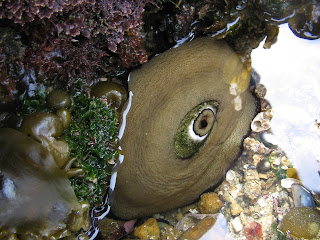
 Scientific name
Scientific name:
Mimulus aurantiacusCommon name: Bush monkeyflower, Sticky monkeyflower
Range: southwestern Oregon through most of California (according to Wikipedia entry)
More information: Calflora.net entry,
Bush monkeyflower; Wikipedia entry, "
Mimulus aurantiacus"
It is sometimes called "Sticky monkeyflower", presumably because the leaves are sticky to the touch. (I will have to try this.)
According to
Introduction to the Plant Life of Southern California (Rundel and Gustafson), the name "monkeyflower" refers to the two-lipped flowers which resemble small faces (from the front).
Also, even within southern California, the flowers vary quite noticeably in shape and color--a curious fact worth further exploration. (Rundel and Gustafson mention that this "may reflect an evolving change from bee to hummingbird pollination").
The stigma (female part) of the monkeyflower is sensitive to touch, like a few other plants (e.g.
Mimosa). It closes shut a few seconds after being touched. (Again, I will have to try this!)
This website says that the young leaves and stems can be eaten, but are quite bitter, and that also it was used as a
poultice by Indians.
According to the Wikipedia entry, monkeyflower "grows in many climates and will thrive in many types of soil, wet, dry, sandy, or rocky. It even grows in
serpentine, a soil that most plants have difficulty thriving in because of its unique mineral composition."
The above photo was taken Sunday on the rim of Badlands Park (elev. about 1000 ft.), at the southernmost edge of Aliso & Woods Canyon, overlooking the Pacific Ocean in Monarch Beach.







 Scientific name:
Scientific name: 










